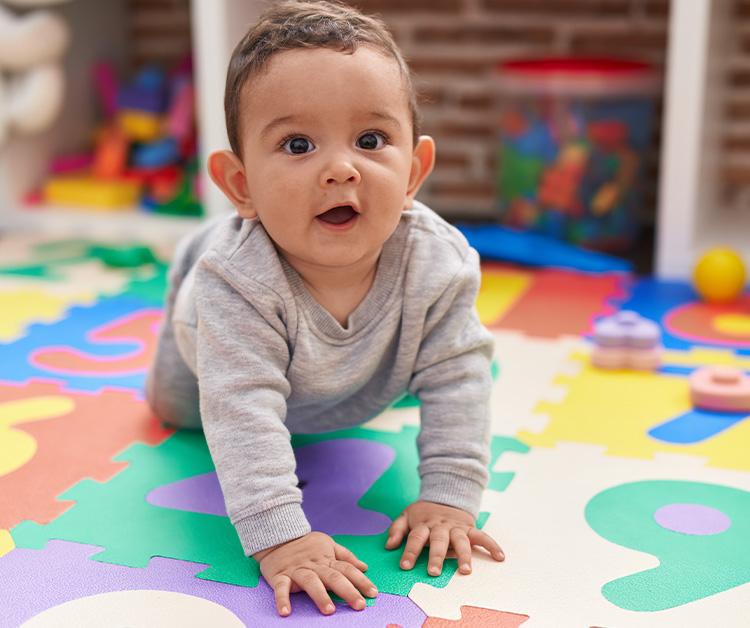Due to maintenance, rewards points for receipt uploads will be delayed. Thank you for your patience!

Crawling marks a big step towards your baby’s independence. Support your baby with these tips.
The crawling countdown is on, and your baby is getting ready to explore their world in a brand-new way. This mobility milestone strengthens muscles, improves coordination, and builds spatial awareness. Let’s explore when and why babies crawl and how you can support your on-the-go little one.
Babies typically start crawling between seven and 10 months. But as with many skills, that timeframe can vary from child to child. Before crawling, babies need to be able to hold their heads up, sit up, roll over, and push up on their arms and legs.
Crawling teaches your little one how to use their muscles and coordinate their arms and legs. Through crawling, your baby develops motor and sensory processing skills, supports their ability to balance, and learns to problem-solve as they navigate the floor.
As your baby reaches seven to 10 months of age, you might notice signs that they're gearing up to explore on their own, including:
Crawling is not something you need to teach your baby, as your little one will reach this milestone on their own. However, as you observe signs that your baby is getting ready to get more mobile, doing the following can help support their crawling development.
Tummy time provides a foundation for crawling by building your baby’s upper body strength and helping them get comfortable lifting their head and shoulders. For added fun, put a baby-safe mirror in front of them. Babies are often fascinated by their reflections, motivating them to lift their heads and explore.
Gently guide your baby’s hands and knees to show them the crawling motion. This hands-on assistance can help them understand the movement and build their muscle memory.
Get down on the floor and crawl. Your baby may want to mimic your movement.
During tummy time, place your little one’s favorite toys just a bit out of reach. This encourages them to move towards the toy, giving them a clear goal.
Your cheers and claps provide positive reinforcement that can boost your baby’s confidence and make them excited to crawl.
Crawling styles come in a variety of wiggles. In fact, some babies skip traditional hands-and-knees crawling and use alternative methods for getting around, like rolling, scooting on their bottom, or slithering on their tummy. Some of the most common ways your baby may move and groove include the following:
Many babies go for the classic hands-and-knees crawl, moving forward with their hands and knees on the ground. It's a steady and efficient way to explore.
The bear claw style is when your baby is on all fours, but instead of moving forward with alternating hands and knees, they move both hands and feet on one side simultaneously, resembling a bear's movement.
In the belly crawl, also known as commando or army crawl, babies use their forearms to push themselves forward while keeping their tummy close to the ground.
Some babies prefer to scoot around on their bottom. This style can be quite effective as they push themselves forward using their legs.
The crab crawl is when a baby uses their hands to move backward and sideways like a crab.
The rolling crawl is just what it sounds like—your little one will roll their way to new areas of the floor. It’s an unconventional but adorable style for getting around.
Some babies start by crawling backward before they figure out the forward motion.
While every child develops at their own pace, always reach out to your pediatrician with any concerns. If your baby is one year old and not sitting up or rolling over, or if their crawling movements are asymmetrical, talk to your doctor. They can evaluate your little one and answer any questions you have.
Watching your baby crawl is an exciting time. But as your little one’s independence grows, so does their curiosity…and their risk of getting into some potentially hazardous situations. Here are some ways to keep your baby safe.
Ensure you've taken all necessary precautions to thoroughly baby-proof your home. Stash away cleaners and medicines, secure furniture, install outlet covers, corner guards, and safety gates and locks.
Create a safe and comfortable crawling environment with a play mat or carpet. Or transform your floor into a mini obstacle course with strategically placed soft cushions your little one can navigate around.
Parents should avoid baby walkers for several safety and developmental reasons. Many babies have been injured falling down stairs while in a walker. Plus, a walker picks up speed quickly, which can get a baby into a dangerous situation in seconds. The devices also do not allow for a proper standing position, potentially impacting a baby’s muscle development.
All information on Enfamil, including but not limited to information about health, medical conditions, and nutrition, is intended for your general knowledge and is not a substitute for a healthcare professional's medical identification, advice, or management for specific medical conditions. You should seek medical care and consult your doctor or pediatrician for any specific health or nutrition issues. Never disregard professional medical advice or delay seeking medical treatment, care, or help because of information you have read on Enfamil.